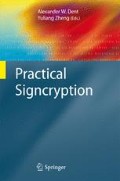Abstract
Signcryption is a cryptographic primitive designed to simultaneously provide confidentiality and integrity protection in a communication (see Chap. 1 for a more detailed description of the role of signcryption in a communication architecture ). It is a public-key primitive and can be viewed as the public-key version of the symmetric-key primitive known as authenticated encryption ; indeed, the two primitives share many similarities at a high level.
Access this chapter
Tax calculation will be finalised at checkout
Purchases are for personal use only
References
J. H. An. Authenticated encryption in the public-key setting: Security notions and analyses. Available from http://eprint.iacr.org/2001/079, 2001.
J. H. An and M. Bellare. Does encryption with redundancy provide authenticity? In B. Pfitzmann, editor, Advances in Cryptology – Eurocrypt 2001, volume 2045 of Lecture Notes in Computer Science, pages 512–528. Springer, 2001.
J. H. An, Y. Dodis, and T. Rabin. On the security of joint signatures and encryption. In L. Knudsen, editor, Advances in Cryptology – Eurocrypt 2002, volume 2332 of Lecture Notes in Computer Science, pages 83–107. Springer, 2002.
M. Bellare and C. Namprempre. Authenticated encryption: Relations among notions and analysis of the generic composition paradigm. In T. Okamoto, editor, Advances in Cryptology – Asiacrypt 2000, volume 1976 of Lecture Notes in Computer Science, pages 531–545. Springer, 2000.
D. Chaum and H. van Antwerpen. Undeniable signatures. In G. Brassard, editor, Advances in Cryptology – Crypto ’89, volume 435 of Lecture Notes in Computer Science, pages 212–216. Springer, 1989.
A. W. Dent. Hybrid signcryption schemes with outsider security (extended abstract). In J. Zhou and J. Lopez, editors, Proceedings of the 8th International Conference on Information Security – ISC 2005, volume 3650 of Lecture Notes in Computer Science, pages 203–217. Springer, 2005.
H. Krawczyk. The order of encryption and authentication for protecting communications (or: How secure is SSL?). In J. Kilian, editor, Advances in Cryptology – Crypto 2001, volume 2139 of Lecture Notes in Computer Science, pages 310–331. Springer, 2001.
H. Krawczyk and T. Rabin. Chameleon signatures. In Proceedings of the Network and Distributed Systems Symposium – NDSS 2000, pages 143–154. 2000.
R. Steinfeld and Y. Zheng. A signcryption scheme based on integer factorization. In J. Pieprzyk, E. Okamoto, and J. Seberry, editors, Information Security Workshop (ISW 2000), volume 1975 of Lecture Notes in Computer Science, pages 308–322. Springer, 2000.
Y. Zheng. Digital signcryption or how to achieve cost(signature & encryption) « cost (signature) + cost(encryption). In B. S. Kaliski Jr., editor, Advances in Cryptology – Crypto ’97, volume 1294 of Lecture Notes in Computer Science, pages 165–179. Springer, 1997.
Y. Zheng. Digital signcryption or how to achieve cost(signature & encryption) « cost (signature) + cost(encryption). Full version. Available from http://www.sis.uncc.edu/∼yzheng/papers/, 1997.
Author information
Authors and Affiliations
Corresponding author
Editor information
Editors and Affiliations
Rights and permissions
Copyright information
© 2010 Springer-Verlag Berlin Heidelberg
About this chapter
Cite this chapter
An, J.H., Rabin, T. (2010). Security for Signcryption: The Two-User Model. In: Dent, A., Zheng, Y. (eds) Practical Signcryption. Information Security and Cryptography. Springer, Berlin, Heidelberg. https://doi.org/10.1007/978-3-540-89411-7_2
Download citation
DOI: https://doi.org/10.1007/978-3-540-89411-7_2
Published:
Publisher Name: Springer, Berlin, Heidelberg
Print ISBN: 978-3-540-89409-4
Online ISBN: 978-3-540-89411-7
eBook Packages: Computer ScienceComputer Science (R0)

